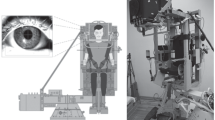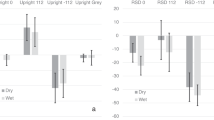Abstract.
To better understand the mechanisms of human adaptation to rotating environments, we exposed 19 healthy subjects and 8 vestibular-deficient subjects ("abnormal"; four bilateral and four unilateral lesions) to an interaural centripetal acceleration of 1g (resultant 45° roll-tilt of 1.4g) on a 0.8-m-radius centrifuge for periods of 90 min. The subjects sat upright (body z-axis parallel to centrifuge rotation axis) in the dark with head stationary, except during 4 min of every 10 min, when they performed head saccades toward visual targets switched on at 3- to 5-s intervals at random locations (within ±30°) in the earth-horizontal plane. Eight of the normal subjects also performed the head saccade protocol in a stationary chair adjusted to a static roll-tilt angle of 45° for 90 min (reproducing the change in orientation but not the magnitude of the gravitoinertial force on the centrifuge). Eye movements, including voluntary saccades directed along perceived earth- and head-referenced planes, were recorded before, during, and immediately after centrifugation. Postural center of pressure (COP) and multisegment body kinematics were also gathered before and within 10 min after centrifugation. Normal subjects overestimated roll-tilt during centrifugation and revealed errors in perception of head-vertical provided by directed saccades. Errors in this perceptual response tended to increase with time and became significant after approximately 30 min. Motion-sickness symptoms caused approximately 25% of normal subjects to limit their head movements during centrifugation and led three normal subjects to stop the test early. Immediately after centrifugation, subjects reported feeling tilted 10° in the opposite direction, which was in agreement with the direction of their earth-referenced directed saccades. Postural COP, segmental body motion amplitude, and hip-sway frequency increased significantly after centrifugation. These postural effects were short-lived, however, with a recovery time of several postural test trials (minutes). There were also asymmetries in the direction of postcentrifugation COP and head tilt which depended on the subject's orientation during the centrifugation adaptation period (left ear or right ear out). The amount of total head movements during centrifugation correlated poorly or inversely with postcentrifugation postural stability, and the most unstable subject made no head movements. There was no decrease in postural stability after static tilt, although these subjects also reported a perceived tilt briefly after return to upright, and they also had COP asymmetries. Abnormal subjects underestimated roll-tilt during centrifugation, and their directed saccades revealed permanent spatial distortions. Bilateral abnormal subjects started out with poor postural control, but showed no postural decrements after centrifugation, while unilateral abnormal subjects had varying degrees of postural decrement, both in their everyday function and as a result of experiencing the centrifugation. In addition, three unilateral, abnormal subjects, who rode twice in opposite orientations, revealed a consistent orthogonal pattern of COP offsets after centrifugation. These results suggest that both orientation and magnitude of the gravitoinertial vector are used by the central nervous system for calibration of multiple orientation systems. A change in the background gravitoinertial force (otolith input) can rapidly initiate postural and perceptual adaptation in several sensorimotor systems, independent of a structured visual surround.
Similar content being viewed by others
Author information
Authors and Affiliations
Additional information
Electronic Publication
Rights and permissions
About this article
Cite this article
Kaufman, G., Wood, S., Gianna, C. et al. Spatial orientation and balance control changes induced by altered gravitoinertial force vectors. Exp Brain Res 137, 397–410 (2001). https://doi.org/10.1007/s002210000636
Received:
Accepted:
Issue Date:
DOI: https://doi.org/10.1007/s002210000636




